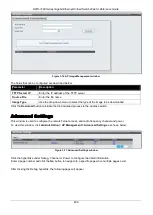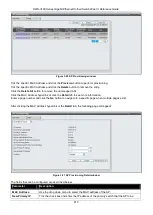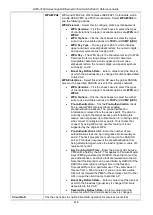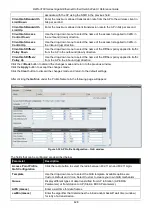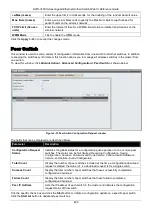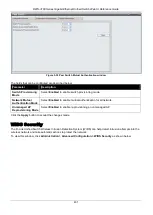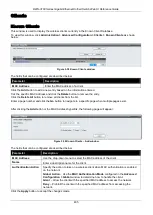
DWS-3160 Series Gigabit Ethernet Unified Switch Web UI Reference Guide
421
Figure 3-29 AP Profile Configuration – Radio window
The fields that can be configured or displayed are described below:
Parameter
Description
Access Point Profile
Radio Configuration
Click the radio button to select the radio between 802.11a/n and 802.11b/g/n.
State
Click to have the radio On or Off.
Mode
Use the drop-down menu to select the Physical Layer standard the radio uses.
When 1-802.11a/n is selected in Wireless Default Radio Settings, available options
are IEEE 802.11a, IEEE 802.11a/n and 5GHzIEEE 802.11n.
When 2-802.11b/g/n is selected in Wireless Default Radio Settings, available
options are IEEE 802.11b/g, IEEE 802.11b/g/n and 2.4GHzIEEE 802.11n.
RTS Threshold (bytes)
Specify a Request to Send (RTS) Threshold value between 0 and 2347. The RTS
threshold indicates the number of octets in an MPDU, below which an RTS/CTS
handshake is not performed. Changing the RTS threshold can help control traffic
flow through the AP, especially one with a lot of clients. If you specify a low
threshold value, RTS packets will be sent more frequently.
This will consume more bandwidth and reduce the throughput of the packet. On the
other hand, sending more RTS packets can help the network recover from
interference or collisions which might occur on a busy network, or on a network
experiencing electromagnetic interference.
DTIM Period (#
beacons)
Specify the Delivery Traffic Information Map (DTIM) period that the clients served
by this access point should check for buffered data still on the AP awaiting pickup.
The DTIM message is an element included in some Beacon frames. It indicates
which client stations, currently sleeping in low-power mode, have data buffered on
the access point awaiting pick-up. The DTIM period you specify indicates how often
the clients served by this access point should check for buffered data still on the AP


